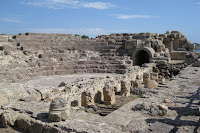
Tuesday, June 23 and we are back in the port of Civitavecchia and on our way home. Baggage must be outside our cabins by 7:00 am, with color coded tags based on what airport terminal we are going to. In port the water is calm and I feel fine. I ate a light breakfast and at 9:00 am we boarded buses to go to the airport.
Continental Airlines flight 0043 from Rome to Newark aboard a Boeing 767-200 took the scheduled 9 hours and 55 minutes. This plane was a little smaller than the previous one; it seated 174 passengers, 25 business class and 149 economy. The overhead displays were similar to what we saw on the trip out. Except this time we had a vento contrario, a head wind, and we flew at altitudine 10973 m, altitude 36000 ft.
The only hitch in transportation for the entire trip was with New Jersey Transit from Newark Liberty International Airport Station to Princeton Junction. There was a disabled train between Newark Penn Station and Secaucus Junction where there are only two tracks. So I was delayed for about an hour. Not bad for a trip that involved over 8000 statute miles by air and over 1000 nautical miles by sea. By about 9:00 pm, still June 23, I was home.
Above, I've repeated the map from the trip brochure. Images of things we saw and stories the guides told us keep popping into my head. Following are some repeated blog pictures and some new stories.

Our guide in Florence told us an interesting story. In the 1960s three high school students each made a sculpture in the style of a famous Florentine sculptor. (I wish I could remember which one.) They took their sculptures and placed them in a canal in Florence. Some time later the sculptures were discovered. The experts were called in and the sculptures were declared authentic. At which point the three young men came forward; announced that they had made them; and that they would make more--for a fee. Our guide told us that we had seen the original Michelangelo statue David inside the Academy of Fine Arts and a copy outside the Old Palace. But there is another famous statue where the original is outside and there is a copy inside a museum. Then he just shook his head. (Image: Inside of the Brunelleschi designed dome of the Santa Maria del Fiore cathedral--the Duomo.)

In Nice the local guide told us a fantastic story about composer Hector Berlioz (1803-1869). Verifying the story in Wikipedia indicates that the guide embellished it quite a bit. The story consistent with Wikipedia goes more along these lines. Berlioz, living in Paris, was engaged to be married. (This woman was not the beautiful French actress with whom he was obsessed most of his life.) He won a music prize which included two years of study in Rome. While there he received a letter from his fiancée's mother saying that her daughter was marrying someone else. Berlioz decided to kill his former fiancée, her husband, and her mother. Berlioz bought a dress with a hat and veil that he planned to use as a disguise to get into a house when the three of them were there. (In the local guide's version, this was a wedding dress.) But, on the way back to Paris by mistake he left the dress on a carriage. Berlioz had gotten as far as Nice. At this point he realized killing the three of them was probably not such a good idea. He stayed in Nice waiting for permission to return to Rome. (In the local guide's version, Berlioz fell in love with Nice.) While in Nice he wrote two overtures and the sequel to Symphonie Fantastique. And he returned to Rome. ('Self portrait' dog sculpture by Alberto Giacometti at the Maeght Foundation and Museum.)

In Bonifacio on the Rue des Deux Empereurs is the house where both Emperor Charles V of the Holy Roman Empire and Napoleon Bonaparte stayed while visiting the area, over 200 years apart. There is a plaque on the outside wall. While there Napoleon rode his host's best horse. After he left, the owner shot this horse. Out of respect for Napoleon he didn't want anyone to be able to say: I rode the horse that Napoleon rode. After Bonifacio we had our second night of stargazing. It began later--a little after sunset. One person spotted a moving light. The cruise director identified it as a satellite. Then someone noticed one moving in a different direction. That was a satellite in polar orbit. (Bonifacio citadel.)

The meal of local cuisine on the island Sardinia ended with an delicious myrtle liqueur. (Roman amphitheater.)

When we were in the Old Medina shopping area in Tunis with its warren of corridors among the stalls our guide told us: Be careful that you don't get lost. Even GPS doesn't work here. (Now that's an example of hyperbole!) (Roman cisterns.)

As we approached a castle in Erice, one person asked: Can we go in? The answer: No, it is being made into a hotel. (Street scene.)

The people on this trip certainly were very interesting and pleasant. In addition to people who were members of the American Museum of Natural History, there were people from the Archaeological Institute of America, the University of North Carolina Alumni Association, Dartmouth Alumni Association, Georgetown University, and people who found out about the trip from travel agents. (Corinthian II.)
This trip certainly whet my appetite for more. So now I am thinking, what exotic place would I like to go to next?









































